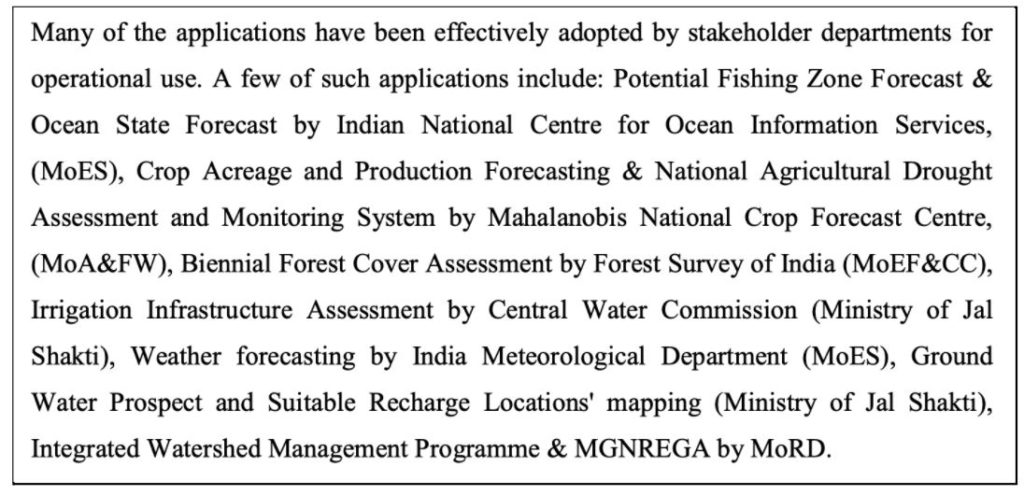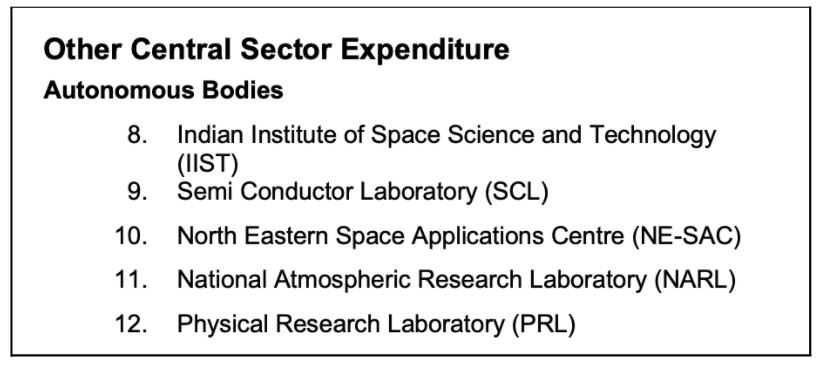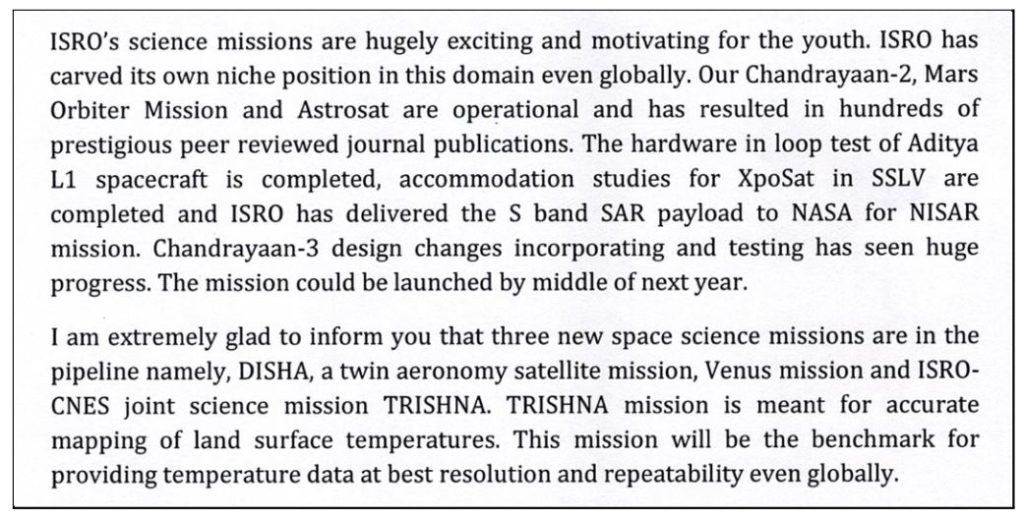India had earlier planned the ‘Gaganyaan’ mission to be achieved by 2022, the 75th anniversary of India’s Independence. However, due to COVID-19, this mission and many other space missions have been delayed. This is also evident in the reduced expenditure of the Department of Space (DoS), particularly the capital expenditure.
In a written reply to a question in the Rajya Sabha in February 2022, the Union government said that the Indian Space Research Organization (ISRO) launched a total of 129 satellites of Indian origin and 342 foreign satellites belonging to 36 countries, since 1975.
With the setting up of the Indian National Committee for Space Research (INCOSPAR) in 1962, Space related activities in the country were initiated. The ISRO was established in 1969. With the impetus for space research over the years, India is now among the handful of countries that have achieved different milestones in space exploration. In the same response, the government stated that India currently has 53 operational satellites in space – 21 being communication satellites, 8 related to Navigation, 21 Earth Observation satellites and 3 science satellites.
These satellites provide services to various sectors including – broadcasting, mobile communication, education, agriculture, etc. underlining the importance of space operations.

Hence, the allocation of resources towards the Space Programme & various space-related activities are important. In June 1972, the Space Commission, and the Department of Space (DoS) were constituted by the Government of India and ISRO was brought under DoS in September 1972.
In this story, we look at the recent trends in budget allocation towards the Department of Space.
Actual Expenditure of DoS fell by 27% in the pandemic year of 2020-21
In an earlier story, we highlighted that the actual expenditure towards the various Departments under the Ministry of Science & Technology reduced in 2020-21 compared to 2019-20. The impact of the pandemic is visible even in the case of the Department of Space (DoS). The Budget estimate for 2020-21 before the onset of the pandemic was Rs. 13.48 thousand crores, higher than the budget estimates for 2019-20. With the onset of the pandemic, the estimates were revised & reduced to Rs. 9.5 thousand crores. The trends in earlier years indicate that the revised Estimates and the actual expenditure are usually higher than the budget estimates.
The actual expenditure of DoS in 2020-21 was Rs. 9.47 thousand crores, around 27% lower than the Rs. 13.02 thousand crores spent in 2019-20. This was only about 70% of the budget estimates for 2020-21.
The budget estimates for 2021-22 were increased to Rs.13.95 thousand crores, but the revised estimates reduced the amount to Rs. 12.64 thousand crores. In contrast to the trend, the budget estimates for 2022-23 at Rs. 13.7 thousand crores are lower than the budget estimates for 2021-22.
Actual Capital Expenditure was around 60% of the budget estimates for 2020-21
As highlighted, the actual expenditure of DoS was only 70% of the budget estimates for 2020-21. Both the revenue expenditure and the capital expenditure of DoS decreased during the pandemic hit 2020-21. However, the major reduction was in the case of capital expenditure.
In 2020-21, the actual capital expenditure was reduced to Rs. 4.63 thousand crores compared to the budget estimates of Rs. 7.78 thousand crores. On the other hand, the actual revenue expenditure was Rs. 4.84 thousand crores compared to the budget estimates of Rs. 5.7 thousand crores. Overall, while the capital expenditure in 2020-21 for the DoS was only about 60% of the budget estimates, the revenue expenditure was more than 80% of the budget estimates.
Over the years, the growth in capital expenditure was higher compared to the revenue expenditure, which is indicative of increased spending towards initiatives like research & building infrastructure. In 2019-20, the actual capital expenditure was Rs. 7.18 thousand crores, 30% higher than 2018-19. This push towards higher capital expenditure was halted in 2020-21, the pandemic year.
In 2021-22, the budget estimates for capital expenditure of DoS were higher at Rs. 8.29 thousand crores. However, the estimates have now been revised to Rs. 6.92 thousand crores while there is no change in the estimates for revenue expenditure. What is evident is that the pandemic has been affecting plans related to research, infrastructure, etc. while revenue expenditure like establishment expenses, salaries, etc. has not been reduced.
Capital Outlay on Space Research reduced by 55 % in 2020-21
The actual revenue expenditure incurred towards Space Research in 2020-21 was Rs. 4.81 thousand crores compared to Rs. 5.78 thousand crores in 2019-20. However, the major fall was in the case of capital outlay on Space research, which was reduced from Rs. 7.18 thousand crores in 2019-20 to Actual spent of Rs. 4.66 thousand crores in 2020-21.
- Under the various heads, the greatest expenditure is towards Space Technology. During 2020-21, the actual expenditure was reduced to Rs. 6.55 thousand crores, compared to Rs. 8.87 thousand crores in 2019-20. For 2021-22 the estimates were revised to Rs. 9.01 thousand crores, compared to the budget estimates of Rs. 10.25 thousand crores.
- Another major head of ‘Space Applications’ also witnessed a fall in the actual expenditure during 2020-21. Even in this case, it is capital component witnessed a major reduction. So is the case with expenditure towards INSAT Satellite Systems.
- The actual total establishment expenditure, which includes the expenditure towards Secretariat and ISRO was reduced in 2020-21.
- The actual expenditure towards various autonomous bodies was also reduced from Rs. 724 crores in 2019-20 to Rs. 633 crores in 2020-21. This expenditure is revenue in nature. The various autonomous bodies whose expenditure is covered under this head include the following.

Impact of the pandemic on Space Missions & Initiatives.
The actual expenditure for 2020-21 indicates a substantial fall in the expenditure compared to the estimates. Even the revised estimates for 2021-22 also indicate a fall in the expenditure incurred by the DoS, when compared to the budget estimates. As highlighted earlier, the reduction was mainly for the capital expenditure indicating an impact on the planned activities & initiatives for research, missions, etc.
This sentiment was shared in Chairman, Space commission’s new year message –2022, where he stated that there were comparatively fewer space launches in the year. As per the Department’s Annual Report 2020-21, there were 11 space missions in 2019-20 while in 2020-21, four were completed and another 5 were expected to be completed by end of March 2021. For 2021-22, the estimates are for 10 project missions.
In the new year message, it is also reported the government was able to successfully implement reforms in the space sector. Two of the initiatives in this direction were the establishment of the Indian National Space Promotion and Authorization Centre (IN-SPACe) and New Space India Limited (NSIL).
- In 2021-22, the government made an allocation of Rs. 10 crores towards INSPACe. It was announced in June 2020 and would be an independent nodal agency under the Ministry of Defence. However, the revised estimates for INSPACe were only Rs. 1 crore. An amount of Rs. 33 crores are provisioned for INSPACe as per budget estimates for 2022-23.
- NSIL was established in 2019, as a Public Sector Undertaking (PSU) of the Government of India and a commercial arm of ISRO. Budgetary support of Rs. 10 crores were estimated and provided for 2019-20. There wasn’t any provision made in 2020-21 while the support of Rs.700 crores was allocated in 2021-22. This is revised to Rs.744.43 crores as per the latest budget documents. As per the update provided by the Chairman, NSIL has turned profitable within the first year of operation and has remitted 154% of its paid-up capital to GOI.
One of the Missions highlighted for 2021-22 in the Annual report was ‘Gaganyaan’, part of which is the first unmanned mission by India. The initial plan was to achieve the mission by 2022, before the 75th anniversary of India’s Independence. However, the government has multiple times mentioned that the program is slightly delayed due to COVID-19, but preparations are on to achieve the mission by 2023.
The overall Gaganyaan project has completed the design phase and entered the testing phase. There are three new Space science missions in the pipeline – (a) DISHA (b) Mission to Venus & (c) TRISHNA. While already launched missions of Chandrayan-2, Mars Orbiter Mission and Astrosat are showing results, design & testing of Chandrayan-3, targeted to be launched in the middle of 2023 are also underway.

The annual report of the department also provided details of the progress made in various initiatives.

ISRO has also contributed towards mitigating the COVID-19 pandemic in the country by providing design solutions for medical equipment & supplies, especially ventilators & oxygen cylinders. One hopes that the expenditure of DoS is back to normal in 2021-22.


